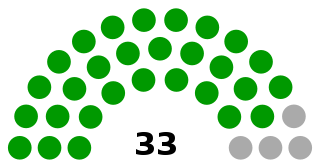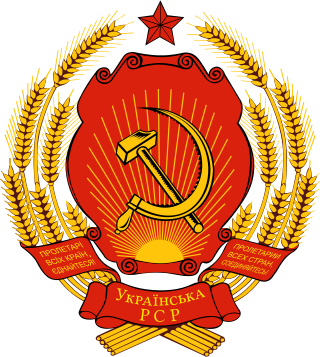
The Supreme Soviet of the Union of Soviet Socialist Republics was, from 1936 to 1991, the highest body of state authority of the Union of Soviet Socialist Republics (USSR), and based on the principle of unified power was the only branch of government in the Soviet state.

Levon Hakobi Ter-Petrosyan, also known by his initials LTP, is an Armenian politician and historian who served as the first president of Armenia from 1991 until his resignation in 1998.

The Supreme Council of the Pridnestrovian Moldavian Republic is the parliament of Transnistria. The unicameral legislature consists of 33 seats, all of which are determined by single mandate constituencies. It is headed by a chairman.

The Oliy Majlis is the parliament of Uzbekistan. It succeeded the Supreme Council of the Republic of Uzbekistan in 1995, and was unicameral until a reform implemented in January 2005 created a second chamber.

The Supreme Soviet of the Lithuanian SSR was the supreme soviet of the Lithuanian SSR, one of the republics constituting the Soviet Union. The Supreme Soviet was established in August 1940 when the People's Seimas declared itself the provisional Supreme Soviet. According to the constitution it was very similar to modern democratic parliaments: it was elected every four years and had the power to create, amend and ratify the constitution, laws, and treaties and appoint officials in the Council of Ministers. However, in reality the elections were staged, the Soviet had very little actual power and carried out orders given by the Communist Party of Lithuania (CPL). The situation changed in 1988, when the Lithuanians began seeking independence from the Soviet Union. The political power shifted from CPL to the Soviet, which adopted a number of important constitutional amendments and laws, paving the way for the independence. The first free elections were held in February 1990 and were won by pro-independence Sąjūdis. During its first session the Supreme Soviet adopted the Act of the Re-Establishment of the State of Lithuania and renamed itself the Supreme Council of the Republic of Lithuania.
The Armenian National Council was a permanent executive body formed by the Armenian National Congress in Tbilisi in October 1917. The Council was responsible for creating the First Republic of Armenia in May 1918, the first independent Armenian state since the decline of the Khachen principality.

The Supreme Soviet was the common name for the legislative bodies (parliaments) of the Soviet socialist republics (SSR) in the Union of Soviet Socialist Republics (USSR). These soviets were modeled after the Supreme Soviet of the USSR, established in 1938, and were nearly identical.

The Supreme Soviet of the Georgian SSR was the supreme soviet of the Georgian SSR from 1938 to 1990.

The Supreme Soviet of the Russian SFSR, later Supreme Soviet of the Russian Federation, was the supreme government institution of the Russian SFSR in 1938–1990; in 1990–1993 it was a permanent legislature (parliament), elected by the Congress of People's Deputies of the Russian Federation.

The Supreme Soviet of the Byelorussian SSR was the supreme soviet and the highest organ of state power of Belarus (Byelorussia), then known as the Byelorussian SSR from 1938 to 1991. It was the only branch of government in the republic, and per the principle of unified power, all state organs are subservient to it. The Supreme Soviet of the Byelorussian SSR was preceded by the All-Byelorussian Central Executive Committee (1920-1938) and the All-Byelorussian Congress of Soviets (1919-1937). The Supreme Soviet of the Byelorussian SSR was briefly disbanded in 1941 due to the Great Patriotic War and was re-established in 1947. The Supreme Soviet of the Byelorussian SSR was briefly succeeded by the Supreme Soviet of Belarus from 1991 to 1996. The Supreme Soviet of Belarus was succeeded by the National Assembly of Belarus in 1996.

An independence referendum was held in the Armenia SSR on 21 September 1991 to determine whether to secede from the Soviet Union. It followed a declaration of independence on 23 August 1990. 99.5% of voters voted in favour, with a turnout of 95%. The country officially became an independent state on 23 September 1991.

The Supreme Soviet of the Uzbek SSR was the supreme soviet of the Uzbek SSR from 1938 to 1991. The Supreme Soviet of the Uzbek SSR was preceded by the All-Uzbek Congress of Soviets which operated from 1925 to 1938. After the independence of Uzbekistan in 1991, the Supreme Soviet of the Uzbek SSR was briefly succeeded by the Supreme Council of the Republic of Uzbekistan from 1991 to 1994.

The Supreme Soviet of the Azerbaijan SSR, later renamed as the Supreme Soviet of the Azerbaijan Republic from 1991 until its abolition in 1995, was the supreme soviet of the Azerbaijan SSR, and later the Republic of Azerbaijan. In 1994, the Supreme Soviet was renamed to the National Assembly and was officially disbanded in 12 November 1995 when a semi-presidential system was implemented.

The Supreme Soviet of the Kazakh SSR, also known as the Supreme Council was a supreme organ of republican power of Kazakhstan, then known as the Kazakh SSR, one of the republics comprising the Soviet Union. The Supreme Soviet was the only government branch in the republic and, under the principle of unified power, all organs were subservient to it.

The Supreme Soviet of the Kirghiz SSR was the supreme soviet of the Kirghiz Soviet Socialist Republic, which was a constituent republics of the Soviet Union. The Soviet was purely ceremonial as power was concentrated in the Communist Party of Kirghizia (CPK).

The Supreme Soviet of the Latvian SSR was the supreme soviet of the Latvian SSR, one of the union republics of the Soviet Union. The Supreme Soviet of the Latvian SSR was established in 1940 as the People's Saeima and finally disbanded in 1990 and was briefly succeeded by the Supreme Council of the Republic of Latvia. According to the 1978 Constitution of the Latvian SSR, representatives could serve an unlimited amount of five-year terms. The Supreme Soviet consisted of 325 deputies before its dissolution.

The Supreme Soviet of the Ukrainian SSR was the supreme soviet and the highest organ of state power of Ukraine when it was known as the Ukrainian SSR, one of the union republics of the Soviet Union. The Supreme Soviet was the sole branch of government in Ukraine, and per the principle of unified power, all state organs were subservient to it. It was established in 1937 replacing the All-Ukrainian Congress of Soviets.

The Supreme Soviet of the Moldavian SSR was the supreme soviet of the Moldavian SSR and later the independent Republic of Moldova from 1941 to 1993. The last elections of the Supreme Soviet of the Moldavian SSR were held in 1990 and 371 deputies were elected.

The Supreme Soviet of the Karelo-Finnish SSR was the supreme soviet of the Karelo-Finnish SSR. The Supreme Soviet of the Karelo-Finnish SSR was established in June 1940 when the third session of the First Convocation of the Supreme Soviet of the Karelian ASSR adopted the law of transforming the Karelian ASSR into the Karelo-Finnish SSR. The first elections of the Supreme Soviet of the Karelo-Finnish SSR took place on June 16, 1940, and the first session of the first convocation took place on November 8, 1940. The Supreme Soviet of the Karelo-Finnish SSR was disbanded in August 1956 when the Karelo-Finnish SSR was demoted to an autonomous soviet socialist republic on July 16, 1956.

The Supreme Soviet of the Turkmen SSR was the supreme soviet of the Turkmen SSR, one of the union republics of the Soviet Union. The Supreme Soviet of the Turkmen SSR was established in 1938 and disbanded in 1992. It was succeeded by the Assembly of Turkmenistan in 1992.




















